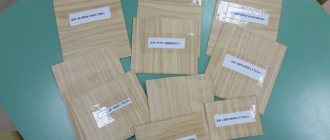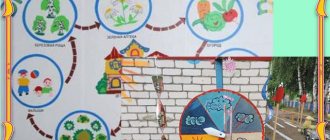Master class for educators “Journey into ecology.”
Master class for educators “ Journey into ecology ” .
Goal: to develop the creative potential of teachers, their competence in the field of ecology; improve the professional skills of teachers and the effectiveness of their procedural activities, establish close cooperation between teachers.
Tasks:
1. Identify the existing knowledge of teachers on environmental issues (phenomena of living and non-living nature, plants, animals)
;
2. The ability to use acquired knowledge by nature in different types of activities;
3. Develop cognitive interest among teachers;
4. Cultivate a love for nature, for your native land.
Seminar progress:
Good afternoon, dear colleagues! Today I will give you a master class on the topic: “ Journey into ecology ”
Today’s seminar will allow each teacher to test their competence in environmental education and, perhaps, improve it a little; share experience in using various forms of activity in order to increase the effectiveness of the pedagogical process on this topic. At the beginning of our seminar, I would like to remind you of the four laws of ecology. They were formulated by the American scientist Barry Commoner.
First Law: “Everything is connected to everything”
.
The second law says: “Everything has to go somewhere.”
.
Nothing disappears without a trace, including garbage that is buried or burned. From one substance another arises, and the air is poisoned, the climate changes, and people get sick.
Third Law: “Nothing comes for free”
.
Everything that we have won by taking from nature, she will take from us in other ways. The sparrows were destroyed - the pests ate the entire crop, the birds of prey were shot - the partridges disappeared. You have to pay for everything.
Fourth Law: “Nature Knows Best”
.
A man arrogantly wanting to “improve”
nature, disrupts the course of natural processes. Nature has no waste: for any organic substance in nature there is an enzyme that can decompose this substance. Well, man has created and continues to create a huge number of chemicals and materials that, when released into the natural environment, do not decompose, accumulate and pollute it.
We must remember that nature very cruelly punishes those who do not comply with its laws.
«Ecological warm-up»
1. When is the sparrow’s body temperature lower: in winter or summer? (same)
2. Whose tongue is longer than the body? (at the chameleon)
3. How is a frog different from a toad? (a frog is a diurnal animal, and a toad is a nocturnal one)
4. Why is the Red Book called red and not green? (because red is a danger signal)
5. Why are the leaves green? (because they contain chlorophyll)
6. Who are called deciduous plants? (hares born in autumn)
7. What does a toad eat in winter? (nothing, she sleeps in winter)
8. Which thread is the thinnest in nature? (web)
9. Which tree is the best vacuum cleaner? (poplar)
10. Who has ears on their feet? (at the grasshopper)
11. What kind of grass do cats like? (valerian)
12. Tallest grass? (bamboo)
13. Is a viper bite dangerous in summer? (No, only the bite of a snake that has just woken up from hibernation is painful and poisonous)
14. What bird does not build nests? (cuckoo)
And now we invite you to solve the ecological crossword puzzle.
Vertically:
1. Our garden is empty, cobwebs are flying into the distance. And the cranes flocked to the southern edge of the Earth. The doors of the schools opened, what month has it come to us? (September)
Horizontally:
2. I sit on a branch all summer, and in the fall I circle around like a yellow butterfly.
3. Someone slowly inflates a red balloon in the morning, and when he lets it go, everything around him will become bright. (Sun)
4. No matter how much you walk along it, everything will run ahead. (shadow)
5. White, like milk, everything around was clouded. (fog)
6. The field turned black and white, rain and snow were falling. It also became cooler, and the waters of the rivers were frozen with ice. The winter rye is fading in the field, what month is it, tell me. (november)
7. The shepherd breeze blew his horn.
The sheep gathered by the heavenly river. (clouds)
8. Everyone who passes by will come up, get drunk and gain strength again for the journey. (spring)
9. Clean, sunny, mushroom, warm, sonorous, mischievous. Grass and rye are reaching towards the sky. Hard worker - summer... (rain)
Physical school
The mice came out one day (Walking in place or moving forward in a column.)
See what time it is. (Turns left, right, fingers “tube”
before your eyes.)
One, two, three, four (Clap your hands above your head.)
The mice pulled the weights. (Hands up and squat with hands down “pulled the weights.”)
Suddenly there was a terrible ringing sound, (Clapping in front of you.)
The mice ran away. (Running in place or to your place.)
Creative task.
A teacher is a creative profession. And what is creativity without imagination and invention? The next task is creative. You need to break into teams, each team needs to draw a proverb so that the opposite team can read it.
1. Spring is red with flowers, and autumn with pies.
2. The apple doesn’t fall far from the tree.
Conclusion:
This concludes our master class, I hope that it was interesting and useful for you. You have refreshed your memory about environmental education. I wish you success in your work on the environment.
For friendship, for smiles and for meetings
We inherited the planet.
We are bequeathed to protect this world
And this amazing land.
Thank you all for your participation!
Master class “Ecological laboratory”
Target:
Share the positive experience of teaching work through research in the field of environmental education of students.
Tasks:
Learn how to make eco-friendly soap at home.
Make detergent, in particular soap, as beneficial as possible for human skin.
To teach how to conduct research with water in an interesting, accessible form for students.
Progress of the master class.
Business card of additional education teachers in the form of a presentation (G. D. Pavlova, R. M. Almakaeva).
Updating. Statement of the problem: quiz “ Ecology of our region.”
Information: “Facts of our life”, “It’s interesting to know.”
Workshop on making soap and studying the properties of water.
Summing up: each participant in the master class will receive the result of their activities in the form of environmentally friendly products - soap and water.
Presentation “Congratulations to colleagues on the upcoming New Year.”
Hello, dear guests! We welcome you to our environmental laboratory. Today you will find a lot of interesting, necessary and essential things for our lives. You will be greeted by two teachers from the socio-pedagogical department.
Presentation of presentations by additional education teachers G. D. Pavlova and R. M. Almakaeva
Our topic is related to ecology. We want to focus on the ecology of our region. Do you know the ecology of the Ulyanovsk region? We’ll find out now.
Name the main water artery of the Ulyanovsk region? (Volga).
How many rivers and streams flow through the Ulyanovsk region? 560, 2030, 4700? (2030).
Name the fish that are found in the Volga? (Pike, bream, pike perch, etc.).
Name the large bottom fish? (Catfish, pike, asp).
What do bottom fish eat? (Mainly - silt deposits).
What is the average depth of the Volga Reservoir near the Imperial Bridge? 9, 13, 21? (9 meters, 3 of which are silt deposits, accumulation of heavy metals: nickel, lead, molybdenum).
Is it possible to eat such fish? (No).
What affects the quality of water in rivers? (Landslides; waste from enterprises dumped into the river; overgrowing of shallow waters; polluted atmosphere; emissions from chimneys of enterprises and cars; the neighborhood to the south - with the Balakovo Nuclear Power Plant in the Saratov Region, nearby the Dimitrovgrad Nuclear Power Plant and the Chernobyl “tail” makes itself felt).
Is it possible to drink tap water? (No).
What kind of water should you drink? (Only boiled water, even spring water must be boiled).
What is the most polluted place in the Volga region? (The area of the Lower Terrace - the pit - is its geographical location. There is an accumulation of heavy metals at a level of 1 m from the ground. The construction of housing on the Lower Terrace was temporary, but everything turned into permanent. In the 60s, five-story buildings were built, and the microdistrict of Zarechnaya Street was built in the 80s.).
What is the most environmentally friendly place in the Volga region? (Upper Terrace area due to forests and non-working factories).
Facts of our life.
54 million rubles were allocated from the Federal budget for the program “Environmental Protection of the Ulyanovsk Region”, and 13 million rubles from the regional budget.
Every day 3 million tons of waste are dumped into the Volga.
Ulyanovsk alone discharges 130 thousand untreated wastewater.
There are 854 sources of centralized water supply in the Ulyanovsk region.
According to the pollution index, Ulyanovsk in the Volga region ranks 2nd after Tolyatti.
The analysis of water quality has deteriorated in terms of sanitary, chemical and micro-biological indicators. Special deviations are visible in the city of Ulyanovsk, Veshkaimsky, Melekessky, Staromainsky districts.
In the New City, the water comes from artesian springs, but this does not mean that you can drink it from the tap.
Among the settlements of the Ulyanovsk region there is an unfavorable environmental situation: the village of the Cement Plant, Novoulyanovsk, Dimitrovgrad.
In the 70s, pesticides were used very widely, and everything in the ground naturally ends up in water bodies.
Phase contact of a person with pesticides leads to changes in the encephalogram of the brain. Pesticides entering the human body cause depression and impaired abstract thinking.
Nitrogen oxides cause bronchitis. Mercury poisons the kidneys. Lead causes cancer of the kidneys, stomach, and intestines. Even ordinary noise causes deafness.
Fireworks are true carcinogens.
In the region, 1000 people get cancer every year, although the incidence has decreased slightly, but the mortality rate has increased due to late visits to the doctor.
Only 8% of 100% of conscripts do not have health problems.
Our region has adopted the “Environmental Protection of the Ulyanovsk Region” program. The goal of this program is to improve the environmental situation in the region. Amount of funding: from the Federal budget - 54 million rubles, from the regional budget - 13 million rubles.
There are 2,030 rivers and streams flowing in the Ulyanovsk region. The main artery is the Volga. Every day 3 million tons of waste are dumped into the Volga. Ulyanovsk alone discharges 130 thousand untreated wastewater. In the coastal zone of the reservoir, the banks are reworked, flooding occurs, shallow waters become overgrown, and landslides negatively affect the quality of water. Water protection measures are not fully implemented due to insufficient funding.
There is an excess in the nitrogen group. The average depth of the Volga Reservoir near the Imperial Bridge is 9 meters, 3 of which are silt deposits, accumulation of heavy metals: nickel, lead, molybdenum. We all know that in nature there is a number of floors, and in water it also exists. Fish live in the Volga: the largest river fish: pike, catfish, asp - these are bottom fish. They feed on silt deposits containing heavy metals.
Is it possible to eat this fish? Sviyaga tells us all the time: you can’t swim in this river, but the entire Right Bank drinks water from Sviyaga and we know well how water smells of chlorine, and chlorine is poisonous even in small quantities. As an example: during the war, chlorine was used as a weapon against us. The Sura River is very beautiful, but you can only admire it. The Penza pharmaceutical plant throws out its waste and everything goes along the Sura. The fish is full of chemicals and cannot be eaten.
There are 854 sources of centralized water supply in the Ulyanovsk region. The analysis of water quality has deteriorated in terms of sanitary-chemical and micro-biological indicators. Special deviations are visible in the city of Ulyanovsk, Veshkaimsky, Melekessky, Staromainsky districts.
In the New City, the water is from artesian springs; it is, of course, cleaner than in the Right Bank, but this does not mean that you can drink it from the tap. In the 70s, pesticides were used very widely, and everything in the ground naturally ends up in water bodies, so water from springs also needs to be boiled. All water must be boiled and then only drunk, since water protection measures, of course, are carried out, but to a very small extent due to lack of funding.
Surface water pollution is influenced by air pollution. Emissions settle with precipitation on the ground and enter the water. These are the chimneys of enterprises and cars. According to the pollution index, Ulyanovsk in the Volga region ranks 2nd after Togliatti.
Among other settlements in the Ulyanovsk region there is an unfavorable environmental situation: the village of the Cement Plant, Novoulyanovsk, Dimitrovgrad. If we talk about the radiation situation, it is also not very optimistic. From the south there is the Balakovo Nuclear Power Plant (Saratov region) and we border on it.
Near Dimitrovgrad Nuclear Power Plant. The Chernobyl “tail” is making itself felt even now (Karsunsky, Inzensky, Veshkaymsky districts).
Phase contact of a person with pesticides leads to changes in the encephalogram of the brain. Pesticides entering the human body cause depression and impaired abstract thinking. Nitrogen oxides cause bronchitis. Mercury poisons the kidneys. Lead causes cancer of the kidneys, stomach, and intestines. Even ordinary noise causes deafness.
I want to dwell on the data of MSU professor, Doctor of Chemical Sciences Petrosyan. He says that the authorities are not aware of environmental problems. In Switzerland, France and other developed countries, 6–8% of the budget is allocated to the environment, but here we have much less. Now we are talking about how to provide Russia with healthy youth. Only 8% of 100% of conscripts have no deviations. We admire fireworks - we go to watch them with our children, and these are real carcinogenic substances. Genetically modified foods lead to decreased immunity.
The most environmentally friendly place in Ulyanovsk is Upper Terrace due to the forest area and non-working factories. The most polluted thing is the Lower Terrace - the pit - this is its geographical location. There is an accumulation of heavy metals at a level of 1 m from the ground. The construction of housing on the Lower Terrace was temporary, but everything turned into permanent. Five-story buildings were built in the 60s; the Zarechnaya Street microdistrict was built in the 80s.
In the structure of deviations from the MPC, the first place is formaldehyde, the second is sulfur dioxide, the third is lead, and the fourth is nitrogen oxides. Adverse environmental factors affect people's health. Cancers are on the rise. In the region, 1000 people get cancer every year, although the incidence has decreased slightly, but the mortality rate has increased due to late visits to the doctor.
Ecology is not a toy; soon there will be no one to develop the Russian economy, because the authorities do not think about environmental problems. If you do not provide the country or region with healthy people, then there can be no innovation in the economy.
At the beginning of the lecture they talked about 54 million and 13 million rubles. What did you do? Dam, landslide situation and cleaning of the Sviyaga River.
All material is in the document.
The world of spiders and ladybugs
An egg tray works well for modeling. It is easy to cut, pierce, and glue.
You will need:
- egg trays;
- wire;
- self-adhesive paper;
- acrylic paints
For clarity, see pictures of crafts made from natural materials.
- Treat egg trays by spraying alcohol on them.
- Cut off the top of the hemispheres. This will be the body of the insect.
- Apply paint and let dry well.
- Stick on the eyes. Pre-prepare them from self-adhesive film.
- Cut the wire into pieces 3–4 centimeters long and form them into legs.
- Pierce the places where the legs are attached in the egg hemispheres.
DIY crafts on the theme of ecology are ready.
The task of teachers is to instill in children a competent attitude towards nature and its resources. This topic is addressed in kindergartens and schools. Parents often learn a lot of new information from their children.
Layout of the natural area
Such prototypes of the environment develop in children concentration, observation, and keen interest in the environment. The main goal of ecology mock-ups is to study the fauna and habitats of animals. When creating it, you needed boxes, cotton wool, branches, leaves, flowers, grass. In general, everything that can be found in the nearest forested area. Your imagination will be needed here. The background of the model was decorated with nature appliqués.
They were used to create trees, mountains, the sun and the sky. Additionally, wire and PVA glue will be useful. Fauna can be represented by any small toys. Depending on what fragment of the planet you want to recreate, use mammals: cows, horses, pigs. For cold continents, take penguins. For hot countries - monkeys and parrots. The photo shows options for crafts made from environmentally friendly materials.


